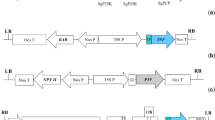Abstract
We constructed a recombinant virus containing a promoter mutation altering the immediate-early expression of the HSV-1 ICP27 transcript, ICP27ΔSma, which contains a deletion of the “TATGARAT” and surrounding sequences, but retains the rest of the ICP27 promoter. This mutant does not exhibit immediate-early expression of ICP27 using criteria of expression in the absence of de novo protein synthesis and earliest expression in the kinetic cascade. While transcript abundance at 1h after infection at 0.1 PFU/cell in mouse embryo fibroblasts was significantly altered compared to infections with wt-rescues, by 4h after infection these differences were diminished or absent. Consistent with this observation, levels of some critical proteins were reduced in the mutant as compared to rescue infections at the earliest times tested, but were equivalent by 8–12h pi. Further, both single and multi-step virus replication was equivalent with both mutants and rescues. Thus, altering the immediate early kinetics of ICP27 leads to a sub-optimal quantitative lag-phase in gene expression but without consequence to replication fitness in vitro.Infections in vivo also revealed the ability of mutant and rescue virus to invade the CNS of mice following footpad injections was equivalent. The nature of the role of immediate-early ICP27 expression is discussed in light of these observations.
Similar content being viewed by others
Reference
Xiao P., and Capone J.P. Mol Cell Biol 10, 4974–4977, 1990.
Arnosti D.N., Preston C.M., Hagmann M., Schaffner W., Hope R.G., Laughlan G., and Luisi B.F. Nucleic Acids Res 21, 5570–5576, 1993.
Bailey A.C., and Thompson R. Intervirology 34, 74–85, 1992.
Gelman I.H., and Silverstein S.J., J Virol 61, 2286–2296, 1987.
Stern S., and Herr W., Genes Dev 5, 2555–2566, 1991.
Kristie T.M. and Sharp P.A., Genes Dev 4, 2383–2396, 1990.
Wilson A.C., Cleary M.A., Lai J.-S., LaMarco K., Peterson M.G., and Herr W. Cold Spring Harbor Symp Quant Biol 58, 167–178, 1993.
Wagner E.K., Garcia R. J.J., Stingley S.W., Aguilar J.S., Buehler L., Devi-Rao G. B., and Ghazal P. Prog Nucleic Acid Res Mol Biol 71, 445–491, 2002.
Zhang Y.-F., and Wagner E.K., Virus Genes 1, 49–60, 1987.
Sun A-X., Devi-Rao G.V., Rice M.K., Gary L.H., Bloom D.C., Sandri-Goldin R.M., Ghazal P., and Wagner E.K., J Virol 2004.
Stingley S.W., Ramirez J.J.G., Aguilar S.A., Simmen K., Sandri-Goldin R.M., Ghazal P., and Wagner E.K., J Virol 74, 9916–9927, 2000.
Aguilar J.S., Roy D., Ghazal P., and Wagner E.K., BMC.Infect.Dis. 2, 9, 2002.
Lieu P.T., and Wagner E.K., J Virol 74, 2770–2776, 2000.
Wagner E.K., Petroski M.D., Pande N.T., Lieu P.T., and Rice M.K., Methods 16, 105–116, 1998.
Yang W.C., Devi-Rao G.V., Ghazal P., Wagner E.K., and Triezenberg S.J., J Virol 76, 12758–12774, 2002.
Yguerabide J., and Yguerabide E.E., J Cell Biochem Suppl (Suppl) 37, 71–81, 2001.
Yguerabide J., and Yguerabide E.E., Anal Biochem, 52, 157–176, 1998.
Yguerabide J. and Yguerabide E.E., Anal Biochem, 262, 137–156, 1998.
Smith I.L., Hardwicke M.A., and Sandri-Goldin R.M., Virology 186, 74–86, 1992.
Bloom D.C. HSV Vectors for Gene Therapy, Brown S.M. and MacLean A.R., Inc. Methods in Molecular Medicine. 10, 369–386. 1999. Humana Press, Totowa, Ref Type: Serial (Book, Monograph).
Bloom D.C., and Stevens J.G., J Virol 68, 3761–3772, 1994.
Tran R.K., Lieu P.T., Aguilar J.S., Wagner E.K., and Bloom D.C., J Virol. 76, 2199–2205, 2004.
Wagner E.K., Guzowski J.F., and Singh J. Transcription of the Herpes Simplex Virus Genome during Productive and Latent Infection. In Cohen W.E., and Moldave K. (ed.), Progress in Nucleic Acid Research and Molecular Biology, Academic Press, San Diego, 1995.
Author information
Authors and Affiliations
Rights and permissions
About this article
Cite this article
Sun, A., Devi-Rao, G., Rice, M. et al. The TATGARAT Box of the HSV-1 ICP27 Gene is Essential for Immediate Early Expression but not Critical for Efficient Replication in vitro or in vivo . Virus Genes 29, 335–343 (2004). https://doi.org/10.1007/s11262-004-7437-9
Issue Date:
DOI: https://doi.org/10.1007/s11262-004-7437-9




